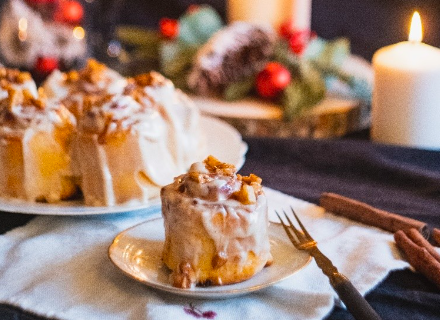With the holiday season in full swing, the spirit of giving, joy, and celebration is in the air! While it’s true that this time can bring on an increase in waste, from gift wrap to packaging and excess food, embracing a mindful approach allows us to revel in the festivities while positively impacting the environment. This blog will highlight six tips on how to reduce holiday waste to help you celebrate in an eco-friendly manner.
1. Use re-usable and natural material in your wrapping
Every year, Canadians generate about 545,000 of waste in the form of discarded gift wrapping and shopping bags, according to Zero Waste Canada.1
Unfortunately, many of the elements included in traditional gift wrapping, including ribbon, stickers, glitter, and foil-based paper and gift bags, cannot be recycled.
A sustainable alternative is wrapping your gifts in 100% fibre-based paper (fortunately, this includes tissue paper). A good way to check whether paper is recyclable or not is to watch what happens when you rip or tear it. If it cannot easily be torn or bounces back into place when you scrunch it into a ball, it is not recyclable.

A woman holds up a git that’s sustainably wrapped with cloth, jute, and a touch of greenery
We recommend using kraft paper or newsprint to wrap your gift – this kind of material lends your presents a rustic, homemade quality that perfectly complements the season. If you have any yard waste bags leftover from the fall, here’s your chance to give them a new lease on life! Cloth is another great, sustainable wrapping material that the recipient can easily re-use for multiple purposes.
Then, instead of accenting your gifts with plastic ribbons or bows, choose natural material such as twine (which, in many areas, can be discarded with organic waste), pinecones, rosemary or lavender sprigs, and cinnamon sticks.
We also recommend using paper labels instead of laminated stickers as the former can easily be tossed in the recycling bin once the metal grommet or tape has been removed. Because of its plastic coating, laminated stickers cannot be recycled and must go in the garbage.
The next best option to using sustainable, natural material in your gift wrapping is to re-use old gift bags before buying new. Also, depending on the types of gifts you’re giving or who they’re for, you can forgo wrapping altogether.
2. Reduce food waste with careful planning
Amidst the holiday feasting, food waste tends to surge. The main reason for this is our tendency to buy more food than we need, either because we want to indulge our family and friends, are worried we’ll run out of key ingredients for a special meal or are influenced by the massive spreads we see in movie and social media.
Whatever the cause, our tendency to overbuy and throw away leftovers (44% of Canadians admit to the latter), can be easily remedied with these tips:
- Consider how many guests you’ll be cooking for, their ages (adults generally tend to each much more than kids), and their dietary preferences and allergies.
- Check your cupboards, fridge, and freezer for ingredients you already own.
- Use the above information to inform your shopping list and stick to it while you’re in the store.
- Store any leftovers properly to extend their longevity. Consider packaging them in individual portion sizes to make it easy for yourself and family members to grab them and go.
3. Opt for Reusable Partyware
If you plan to host gatherings, choose reusable plates, cups, and utensils over their disposable counterparts. This is eco-friendly and adds a touch of elegance to your parties. In unavoidable situations where disposables are necessary, reach for those crafted from compostable materials.

A festive dessert is complemented by reusable cloth napkins.
4. Make eco-friendly decorations at home
When decorating your house, choose decorations that stand the test of time. Invest in durable, high-quality ornaments, steering away from the disposable trend. Many decorative items, including Christmas tree ornaments, can also be made from common household items. Here are our favourite ideas:
Paper: From simple cut-out paper snowflakes to intricate origami stars and lanterns, there’s a paper-based ornament or decoration for every skill level. Choose brightly coloured paper with interesting patterns for an eye-catching look or stick to white printing paper from the office for a clean, minimalist vibe. Paper from old books can give your decorations a vintage, romantic flair.

A blue paper snowflake with a deer print.
Cloth: Crochet or knit one-of-a-kind stockings, wreathes, and garlands or stich together snippets of old clothes, blankets, and dishtowels.
Old bottles and mason jars: Mason jars seem to the household staple with seemingly endless craft potential. Drop tealight candles inside to create mini lanterns and enhance the festive factor by applying tissue paper mache to the outside. Stick foliage collected from your yard, including needles and branches from spruce, fir, and cedar trees into glass bottles.
Dried fruit: easy to obtain and prepare, dried orange slices can be strung together for an aromatic garland and accented with popcorn and pinecones.
5. Properly Dispose of Your Christmas Tree
When the time comes to bid farewell to your Christmas tree, do so responsibly. Remove all decorations before disposal to facilitate the recycling process. Then, check with your local waste management or municipality for tree recycling programs. Many communities offer curbside pickup or designated drop-off locations where trees are chipped into mulch for parks or garden use. By opting for proper Christmas tree disposal, you contribute to a greener post-holiday season and help nurture the environment.

Someone taking an old Christmas tree to the curb.
6. Illuminate Responsibly with LED Lights

A red front door decorated with garland and Christmas lights.
Transform your holiday lighting into an eco-conscious spectacle by opting for LED bulbs. Beyond their energy efficiency and prolonged lifespan, LED lights are resilient – a single breakage does not disrupt the entire strand. Enhance energy conservation by utilizing timers and incorporating solar-powered lights in outdoor displays. This not only saves energy but also minimizes your reliance on disposable batteries.
If your lights stop working, do not put them in the trash. LED lights have special disposal considerations and must be discarded as household hazardous waste. Contact your municipality to locate the closest HHW depot near you. Refer to our surprising items you cannot recycle blog for guidance on how to dispose on similar items.
We hope you and your loved ones have a happy, healthy and safe holiday season!
